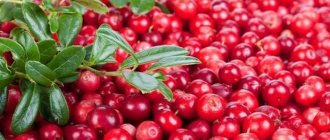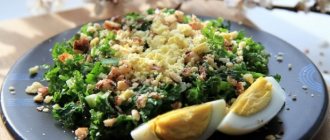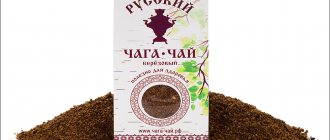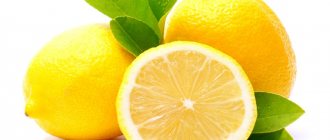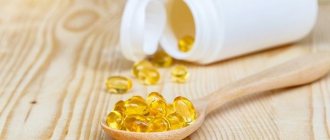Is it possible to have cranberry juice, jelly and juice for gastritis?
Gastritis quickly passes from the acute stage to the chronic stage.
It often does not have obvious symptoms, and only periodically makes itself felt with indigestion, heaviness in the stomach, bad breath, and flatulence. Most patients put up with these phenomena for years, attributing them to stress and being picky about their diet only during periods of exacerbation. Such negligence develops into serious health problems: foci of inflammation and ulcers appear, the pH environment of the stomach walls changes, and degenerated cells form malignant neoplasms.
Cranberries for gastritis with low acidity are an effective and affordable way to strengthen the body’s immune system and help it overcome pathological processes.
The consumption of berries, which have a pronounced sweet and sour taste, is strictly prohibited in case of high acidity and stomach ulcers. For atrophic gastritis and gastritis with low acidity, cranberries are recommended to be included in the diet, carefully following the recommendations of doctors, doses and frequency of consumption. The patient should monitor his own body’s reaction to consuming this berry.
Harmful factors causing gastritis with low acidity of gastric juice:
- simultaneous consumption of incompatible products;
- abuse of food containing preservatives;
- consuming too hot food;
- circulatory disorders;
- alcohol abuse;
- autoimmune pathologies;
- metabolic disease;
- diseases of the endocrine system;
- lung pathologies.
The listed deviations in the functioning of the human body contribute to damage to the gastric mucosa and destroy its epithelium. The next stage following these disturbances is a change in the production and composition of gastric juice due to hypoxia and impaired blood supply, which prevent cell restoration.
For gastritis with high acidity, cranberries are contraindicated. However, uncontrolled use of cranberries can be harmful to people with low stomach acidity, so each case requires an individual approach to dietary choices.
Where do cranberries grow?
The common cranberry is an inhabitant of ancient swamps, the age of which is estimated at millions of years. Her favorite places are peat, tundra and sphagnum bogs, which are located in damp coniferous forests and swampy lowlands. Cranberries in swamps grow only in ecologically clean places, where there is fresh water, forest air, and a lot of light. It bears fruit well in areas where humans rarely set foot.
The time when cranberries are harvested is in summer, autumn and spring. The “summer” berry is hard, not ripe, and contains a small amount of useful substances. “Autumn” acquires a purple color and juiciness: this is the time to collect healthy berries. But there are lovers of “spring” cranberries, which become sweeter, but practically cannot be stored.
Manual collection is very difficult and time-consuming. “Cranberry plantations” are found in different places. For the miracle berry you need to go in good equipment: viscous soil under your feet, mosquitoes, horseflies and picking each individual berry is not for the weak. There are hand-held collection containers, but environmentalists prohibit them. Such devices injure the bushes, which may not recover. So the supply of berries is gradually depleted.
Any schoolchild will answer the question where cranberries grow in Russia. Since we live in the middle and northern latitudes, sour berries are common in the northern regions: Siberia, the Urals, Kamchatka, Sakhalin, and the Far Eastern District.
A variety of wild large-fruited shrub common in Canada. The berry grows up to 25 mm in diameter. Based on wild plants, cultivated large-fruited varieties have been created that can be grown on your own plot.
Cranberry juice for gastritis
To avoid a negative effect, fruits and berries for gastritis should be prepared in advance: pureed, baked, boiled, made into purees, jelly, mousses, jellies, compotes, jams.
Watermelon
Watermelon is one of the few berries that are allowed for any gastritis - provided that they are ripe and grown using environmentally friendly technologies. The juice of mahogany fruits saturates the body with natural sugar, cleanses it of toxins and excess liquid. Fiber stimulates the intestines, “sweeping” accumulations of food debris out of it.
However, doctors warn against consuming excessive portions of this berry, which is unlike all others, and recommend using... watermelon rinds. That is, watermelon is considered as a berry for gastritis with high acidity not as a food product, but as a medicine.
- The remedy is prepared in this way: the dried peels are crushed and poured with boiling water (10 tablespoons per 1 liter of water). Drink warm on an empty stomach, one glass at a time, half an hour before breakfast.
Watermelon is contraindicated for kidney stones, diabetes, pancreatitis, prostate adenoma, colitis, postoperative adhesions.
Cranberry
Cranberries are one of the most popular berries; it attracts attention due to its unique properties, which are still being studied by pharmacists and nutritionists. Cranberries contain:
- antioxidants;
- glucose and fructose;
- organic acids;
- pectins;
- tanning components;
- vitamins;
- microelements.
Cranberries and their products are used as a vitamin, antipyretic, diuretic, antibacterial, thirst-quenching, and general tonic. In the old days, cranberries were used in the fight against scurvy, and today they note the positive effect of cranberries in antibiotic treatment: the berry or its juice enhances the effectiveness of these medications.
Among other organic acids, cranberries contain benzoic acid, which has the qualities of a natural preservative. Thanks to this, the berries do not require special processing. Another feature of cranberries is optimal balance and absorption of beneficial components.
Unfortunately, such a useful berry is contraindicated for gastritis with high acidity. Cranberries are also not recommended for intestinal ulcers and liver problems. Cranberry also has a negative effect on tooth enamel, although it has a strengthening effect on the gums.
Dates
Dates are considered heavy food. They are also called “bread of the desert.” These are healthy fruits because they contain proteins, fats, carbohydrates, oils, pectins, and a dozen and a half minerals and vitamins. Dates are consumed dried, used in compotes, baked goods, salads and other culinary recipes. It is recommended to eat dried fruits in their pure form 15 minutes before meals, and a single serving should not exceed 50 g.
There are conflicting opinions regarding the use of these berries for gastritis.
- Thus, some experts are categorically against this product in the diet of people with acute and chronic forms of gastritis, because the abundance of plant fibers in these fruits provokes an exacerbation of diseases.
- Others consider it acceptable to use exclusively dried dates for all gastritis.
- Another recommendation: date berries for gastritis with high acidity are allowed on the menu for dessert, in limited quantities.
Such disagreement indicates one thing: each patient should decide individually how to treat dates, and act in accordance with the doctor’s recommendations and well-being. It should be borne in mind that dates contain a lot of sugar. Therefore, they are not recommended for people with diabetes and overweight - just like figs, grapes, bananas, and sweet plums.
Plant characteristics
This is a shrubby plant, small in height. It begins to bloom in June, bears fruit from September and throughout the fall; the berries can reach up to 2 cm in diameter. Prefers to settle in swampy areas. It usually grows in cold and temperate climates.
Due to its creeping nature, it presents difficulties when picking berries. Since the stems spread along the ground. But this cannot be compared with its useful and unique properties and wonderful taste. And also, harvesting such a harvest will seem like a good workout for the human body.
Beneficial properties of cranberries
Cranberries grow in swampy areas and in sphang coniferous forests in the northern regions of the country. The fruits of this evergreen shrub are harvested in October. It is not afraid of frost. Even under a layer of snow, the plant does not lose its beneficial substances and properties.
Beneficial features:
- helps strengthen the immune system;
- heals wounds;
- has an antibacterial effect;
- helps fight viruses;
- used to treat headaches;
- excellent antipyretic;
- strengthens body tone;
- “resolves” cholesterol plaques.
Vitamins and minerals
The fruits of marsh cranberries have a rich chemical composition. Per 100 g of berries there are 3.1 g of acids of organic origin: quinic, chlorogenic, citric, ursolic, oxalic, benzoic. The product contains: proteins, fats, carbohydrates, dietary fiber, saccharides, glucose, fructose, ash.
A set of chemical elements determines the benefits and harms of berries for people with stomach diseases. The presence of a large amount of acid does not allow increasing the recommended daily doses. If there are no contraindications to the use of cranberries, use ready-made tinctures and drinks with caution.
Macro- and microelements, vitamins:
- potassium, cobalt, silicon, calcium;
- vitamins: E, C, group B, PP, K, D;
- biotin, choline, beta-carotene;
- vanadium, manganese, lithium, molybdenum;
- manganese, boron, sodium, phosphorus.
Properties of cranberries
Cranberries are one of the healthiest berries. It alone can prevent the formation of caries and various gum diseases, it actively and effectively fights urinary tract infections, and is also an excellent tool for the prevention of cardiovascular diseases. Cranberries are especially useful in the off-season, as they increase immunity and strengthen the body.
The berry is considered a real storehouse of vitamins and minerals. It contains organic acids, vitamins B, PP, K1 and C, and healthy sugar. Cranberries contain a lot of potassium, phosphorus, iron, manganese, copper, calcium, iodine, and zinc. Cranberries are rich in anthocyanins, phenolic acids, leukoanthocyanins, catechins, betaine, macro and microelements.
Cranberries are one of the healthiest berries
Cranberries are one of the main sources of antioxidants - substances known to protect the body from the negative effects of free radicals and prevent premature aging, the development of cancer and cardiovascular diseases. The benefit of cranberries is that it lowers cholesterol and prevents the formation of plaques in blood vessels and the formation of blood clots.
Cranberries also treat gastritis, improve appetite and normalize digestion. Cranberries are an excellent diuretic and therefore useful for pyelonephritis. And one or two glasses of natural cranberry juice, drunk daily, will prevent genitourinary infections.
The beneficial properties of cranberries are endless, but there are very few contraindications. Unless it is not suitable for people suffering from stomach ulcers and weakened tooth enamel. Well, those who are prone to obesity should not get carried away with dried cranberries, because when dried they become very high in calories.
Properties of cranberries for stomach diseases
Doctors do not recommend consuming cranberries for people with gastric or duodenal ulcers, and it is also contraindicated for people with high acidity gastritis.
For diseases of the gastrointestinal tract and pancreas, dilute cranberry juice with water in a ratio of one to one and drink one hundred grams a quarter of an hour before meals.
It is not recommended to take cranberries during an exacerbation of an ulcer, with duodenal disease, and it is also contraindicated for people with high acidity gastritis. Berry acids can irritate the mucous membranes of internal organs. Cranberry juice may cause stomach upset or diarrhea.
Is it possible to eat cranberries for gastritis?
In case of severe inflammation in the gastrointestinal tract, the use of this berry is contraindicated, especially with a stomach ulcer. The same rule applies to conditions when the acidity of gastric juice is increased.
But in cases where we are talking about gastritis with low acidity, eating cranberries is not only possible, but also necessary. After all, it is this berry that will be able to provoke a much-needed increase in the level of acid in the stomach. It is recommended not to consume fresh berries or juice before meals so that the gastric mucosa is not irritated and gastric juice is not released in large quantities.
Possible risks
Harm from berries for gastritis with high acidity occurs when consuming sour fresh fruits, which increase acidity and irritate the gastric mucosa.
To avoid a negative effect, fruits and berries for gastritis with high acidity should be prepared in advance: pureed, baked, boiled, made into purees, jelly, mousses, jellies, compotes.
During exacerbation of the disease, raw berries and juices should not be eaten. Outside of exacerbations, you can: they are useful for intestinal function.
Gastritis is an insidious disease, as it very quickly passes from the acute stage to the chronic stage. And people often do not consult a doctor on time, believing that periodic heaviness in the stomach and various digestive disorders will go away on their own.
As a result, the disease can progress, causing serious consequences. One of the important conditions for recovery is diet. Let's figure out whether cranberries will be useful for gastritis.
Is fruit juice good for stomach diseases?
A fantastic complex of vitamins makes cranberries a healthy food product and a healing drug that helps cure dozens of diseases. Regular consumption of cranberry products improves overall tone and helps fight infection.
According to gastroenterologists, this drink is an excellent preventive measure for ailments affecting the stomach and intestines. Unlike some products, fruit juice increases secretion and can prevent indigestion and gastritis, accompanied by a decrease in acidity.
Without a doubt, the medicinal properties of the drug are excellent. However, cranberry juice for gastritis can still cause harm if consumed incorrectly or excessively. This is especially true for patients whose illness is accompanied by increased secretion. The drink provokes irritation, and this entails an exacerbation of the disease. And if gastritis worsens, it can end in serious erosions and even ulcers.
It is not recommended to drink the tincture in large volumes, even with normal or low acidity. We are talking about 3 liters. At best, you will experience diarrhea, and at worst, serious digestive problems. And if you use store-bought cranberry juice for gastritis with high acidity, it won’t end well either. Juices sold in supermarkets contain additional preservatives, flavorings and flavor enhancers. Is it worth talking about how harmful they are even for a healthy person?
Cranberry Recipes
Folk and culinary recipes from cranberries are simple and accessible. Anyone can make fruit drink, jelly or juice. However, people with stomach problems should take any remedy as a medicine, and not as a dessert.
Cranberry juice for gastritis suppresses pathogenic viruses and bacterial infections. It neutralizes pathogenic microorganisms that destroy the walls of the stomach, reduces inflammation, increases the secretion of gastric juice, thereby helping to break down food.
- A glass of berries is crushed with a tablespoon or fork. You can use a blender. Pour the finished pulp into 6 glasses of warm water, add 2 tablespoons of liquid honey and stir. You can infuse the drink at room temperature for about 40 minutes or in a water bath, but no more than 5 minutes. Drink this cranberry juice for gastritis 15 minutes before meals. You should start with 50 ml. If the body can cope with the load, the amount of fruit drink at one time can be slightly increased.
- Berry fruit juice mix will make your diet table much tastier and more interesting. To prepare, take 100 g of cranberries and 100 g of raspberries or sweet strawberries. The raw materials are kneaded to a paste-like consistency. You can add one or two spoons of honey. Everything is mixed and poured with a liter of warm boiled water. Drink a glass of this drink before meals.
Kissel
Cranberry jelly is made from fresh or frozen berries.
Ingredients:
- cranberries – 500 g;
- sugar – 4 level tablespoons;
- potato starch – 1 tablespoon;
- water – 1 l.
Lightly mash the berries with a spoon, add water, add sugar and put on fire. When the compote boils, pour a glass of cold water with diluted starch into it. With continuous stirring, bring the saucepan to a boil and immediately remove from the heat.
How to make cranberry juice
Fruit juice differs from compote in its high content of vitamins, it remains fresh and is almost impossible to heat treat. The product prepared at home can be rolled into sterilized jars, but it is better to store it in the refrigerator or freeze fresh berries and prepare a new portion of fruit juice from them each time.
Homemade fruit juice is much healthier than store-bought fruit because it does not contain harmful sweeteners or preservatives. For health purposes, it is best to drink pure berry juice, but if it seems too sour, mix it with sweet fruit juice: pear, apple, mango. If desired, you can add a little honey or sugar, but it is better to do this before use.
Recipes
- To prepare a fruit drink from fresh berries, simply rub them thoroughly through a sieve and strain out the juice. After this, the healthy and vitamin-rich cake is poured with a small amount of water and boiled over low heat for 5-6 minutes. If necessary, add sugar to taste and spices: cinnamon, cloves, ginger, cardamom, aromatic herbs. Then the broth is decanted, combined with the juice while warm and infused until it cools completely (or rolled into jars while the liquid is hot).
- Another recipe option is made from frozen berries. In this case, pour hot water over the berries, grind in a blender and leave for 15–20 minutes. Then the same process is done: the first infusion is poured through cheesecloth, the cake is brought to a boil in the second water or syrup, then both parts are mixed.
- An alternative recipe for vitamin juice eliminates boiling. The pureed berries are poured with hot boiled water and left in a thermos, after which the mixture is filtered. This fruit drink should be drunk immediately, since it has a much shorter shelf life. However, antibacterial substances allow it to be stored even without the addition of preservatives.
Harm and contraindications
Despite all the beneficial qualities of this berry, you still shouldn’t relax too much. Some people need to weigh the pros and cons before they decide to eat this fruit. And that's why:
- People suffering from liver diseases are not recommended to eat it,
- It is also worth avoiding those who have increased stomach acidity, since the acids that make up the berry irritate the mucous membranes.
- People with digestive problems should think twice before eating raw berries, all for the same reason, the presence of acids in the composition that irritate the mucous wall of the hollow stomach and intestines,
- Hypotensive people should also be wary, since the berry has the property of lowering blood pressure,
- Cranberry is also not suitable for sensitive teeth, as it has a bad effect on the enamel, making it more vulnerable (oh, those acids!).
Well, if you are very hungry for cranberries, then it is recommended to follow some rules to reduce the risk of harm to your body:
- Do not eat on an empty stomach,
- Rinse your mouth thoroughly after eating berries to reduce the effect of acids on enamel,
- It is advisable not to boil the fruits, but simply pour hot water over them, this way you will definitely not lose valuable components.
Weak teeth
If you are a frequent visitor to the dentist, constantly treat chronic diseases of teeth and gums, and cannot tolerate sweets, hot or cold foods, the beneficial properties of cranberries for the human body do not apply to you! Its juice contains a high concentration of acids. These are substances that are capable of dissolving weaker elements. These include tooth enamel. After eating cranberry desserts, tooth sensitivity can become severely aggravated.
Allergy
Rash, itching, spreading red spots are a sign that your body absolutely does not like cranberries. Cranberries and citrus fruits are often strong allergens, so they are not given to women during breastfeeding and small children, i.e. during times of great vulnerability of the immune system.
Gout and urolithiasis
Both pathological processes are associated with disruptions in the functioning of the body and metabolism. Cranberry, as a strong stimulant and antibiotic analogue, can cause an exacerbation of the disease. The effect cannot be calculated in advance, so the berry is completely excluded, regardless of the beneficial properties and contraindications.
Digestive system diseases
Cranberries contain many acids that can damage the mucous membrane. Contraindications for ulcers and gastritis cannot be mitigated.
Use of berries during pregnancy
There are no substances in cranberries that have a negative effect on the human body, but excessive consumption of this berry is undesirable.
The plant is contraindicated:
- ulcers;
- people with high acidity;
- children under 3 years old.
Before eating berries, you should consult your doctor, undergo an examination, and do full tests. Based on the primary symptoms, it is not possible to determine the degree of development of gastritis or ulcers. It is advisable to monitor your own body’s reaction to the components of this berry. Cranberries should be consumed within reasonable limits, despite the optimal acidity level.
Berries contain a large amount of phytosterols, fiber, and pectins. Constant consumption of cranberries is bad for tooth enamel, so you need to rinse your mouth every time after eating.
It is worth noting that lingonberries, unlike cranberries, have one more property. It is capable of absorbing harmful radioactive substances. Therefore, berry picking should be carried out as far as possible from factories, industrial enterprises and highways.
Cranberries and lingonberries, whose beneficial properties are extremely diverse, are contraindicated for the following problems:
- Liver problems, acute diseases of this organ.
- Stomach or duodenal ulcer.
- Blood pressure too low.
If any of the above problems concern you, you should consult your doctor before using the berries.
Many doctors recommend eating cranberries or lingonberries during pregnancy. During this period, the woman faces some complications and unpleasant symptoms. Berries can have the following effects on the expectant mother’s body:
- They make blood vessels elastic, which is very important during pregnancy.
- Lingonberry juice eliminates anemia and neuroses, and also lowers blood pressure.
- A decoction of lingonberry leaves eliminates constipation and fights swelling.
- Fresh cranberries improve immunity.
- Prevents the formation of microbes in the bladder.
It is advisable to consult a doctor before using any of these tips, since during pregnancy additional complications may arise that prevent you from eating certain foods, including berries.
For therapeutic and prophylactic purposes, it is necessary to drink at least 300 ml of cranberry juice per day. Knowing that about 1 liter of juice is obtained from 1.5 kg of berries, you can prepare a drink of any concentration for daily use.
Is it possible to eat cranberries for gastritis?
To answer whether people with gastritis can eat cranberries, they need to undergo an examination to find out the level of acidity of gastric juice. If the disease occurs with increased production of hydrochloric acid, then the sour juice of the berries can be harmful and even provoke an attack.
But with low acidity in the stomach, cranberry can be beneficial. Thanks to the presence of antiseptic components in the berry, it is possible to quickly cope with the bacteria Helicobacter pylori, which is the main causative agent of gastritis.
You should not expect that cranberry juice, which is sold in bags in stores, will have a healing effect. It is necessary to prepare drinks from fresh berries.
But even with gastritis with low acidity, you need to eat berries with caution. You should not abuse them, as this can cause harm. Cranberries are used to make drinks.
Cranberries for children
Can cranberries be given to children and at what age? This berry has a beneficial effect on the formation of bones and muscles, serves to prevent colds, stimulates appetite and promotes the health of our skin. It will be enough to periodically give your child drinks from its fruits, and the child’s body will be more resistant to colds at school, on the street, in transport. If dried cranberries are included in a child’s diet as a sweet, they will serve as a good source of vitamins and additional protection during a period when the child’s immune system is weakened.
Children's first “acquaintance” with this berry should not take place before the baby turns 1 year old. The medicinal properties of these fruits will strengthen the immune defense of the child’s body and contribute to a speedy recovery from colds. Cranberries are not recommended in cases where the child has ulcerative diseases of the gastrointestinal tract. You should limit your consumption of berries if your child has a food allergy.
What is healthier - cranberries or lingonberries?
Since ancient times, in folk medicine, cranberries and lingonberries have been used as a means to heal mechanical damage, brewed as cough tea, and medicinal decoctions and infusions made from them. The range of beneficial properties of these berries is much wider than most people think. Cranberry has the following properties:
- Fights viruses.
- Reduces temperature.
- Helps antibiotics cope with the disease.
- Kills germs.
- Helps cure diseases of the genitourinary system.
- Normalizes blood pressure levels.
- Promotes smooth functioning of the digestive system.
- Reduces the amount of “bad” cholesterol in the blood.
- Improves the functioning of the cardiovascular system.
- Eliminates rheumatism.
- Fights all colds.
- Improves appetite.
- Stimulates mental abilities.
Lingonberry is not inferior to its rival in its beneficial properties. It has the following effects on the body:
- Fights viruses.
- Has antipyretic properties.
- Helps eliminate problems of the genitourinary system.
- Prevents the appearance of kidney stones.
- Removes toxins from the body.
- Strengthens membrane walls.
- Fights rheumatism.
- Eliminates harmful microorganisms.
- Helps lower blood pressure.
- Reduces blood cholesterol.
- Resists the formation of fatty deposits in the liver.
- Struggling with poor health after alcohol intoxication.
Only lingonberries and cranberries have this set of necessary components that affect the body. A comparison of the beneficial and medicinal properties of these berries will not be complete if contraindications to the use of plants are not taken into account.
Particularly beneficial properties of cranberries
Of course, cranberries have many beneficial properties, but let’s highlight particularly important properties:
- The berries contain enzymes that prevent pathogenic bacteria from gaining a foothold on the walls of the genitourinary tract. By combining with other substances from cranberry juice, enzymes create a new substance. It has a beneficial effect on the potency of men.
- For women, these enzymes are useful primarily for their disinfecting properties. Chronic diseases, especially cystitis, are eliminated by cranberry juice. Another benefit of cranberries for the body is that it prevents the problem from returning.
- During pregnancy, cranberries become the main source of flavonoids in the diet of the expectant mother. These substances promote better absorption of vitamin C and strengthen blood vessels. Cranberries also normalize hormone production.
- Fiber and tannins, which cranberries are so rich in, regulate weight. Enriched food removes toxins from fat depots, speeds up metabolism, and reduces appetite.
Berry storage
Fresh cranberries will delight the eye for 2-4 months. Of course, this also depends on the storage conditions. The berries can be frozen perfectly, all you need to do is wash them, remove excess debris and spoiled fruits. After washing, it must be thoroughly dried and put into bags and put in the freezer. In harsh winters, a fruit drink made from this berry will warm you up and give you magical thoughts of summer. You can freeze the berries, grated, with sugar. You can dry the cranberries in the oven if you wish.
By being interested in your health and the characteristics of certain things surrounding a person, you can minimize harm from the environment. Get a boost of energy and improve your mood.
